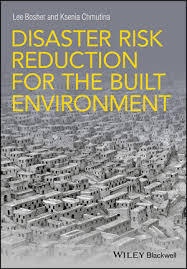
In this book, authors Lee Bosher and Ksenia Chmutina argue that to achieve better design and construction of the built environment to withstand and recover from catastrophic risks, a wider range of stakeholders need to become involved in developing more proactive strategies. A key contrast in the volume is between whether disaster risk reduction considerations are brought forward into project conception and design and company policy or whether risk reduction is an afterthought. The volume develops a series of guilding principles for developing a "A holistic multi‐hazard/threat and multi‐stakeholder approach," with the goal of increasing the relience of the built environment to catastrophic events. The book covers a range of hydro-meteorological and geological risks.

In Disaster By Choice (Oxford University Press, 2020), Ilan Kelman begins with a grim account of the 2010 Haitian earthquake. The devastating impact of this "natural disaster," he argues, ultimately depended on "entrenched disaster vulnerabilities" that are man-made (14). Turning to episodes of wildfires and flooding in other parts of the world, he argues that natural events "become hazardous only when faced by an unnprepared society" (40). Hazards are "made" by human choice. But he also asks "whose choice?" He writes that "[v]ulnerability and poverty feed off each ofther through a lack of resources which prevents people from having choices that, if acted on, would helpt to reduce their vulnerability" (78). For example, the poor often have little choice in migrating to areas prone to hazard. As a result, responding to vulnerability requires "identifying the people, groups, politics, power games and social structures responsible for decisions to create disaster vulnerability" (95). If vulnerability is produced by choice, it can also be reduced by choice, and Kelman then investigates how certain communities (Seattle, Toronto, villages in Bangladesh) have sought to address earthquake and flooding risks.
cc
Collapsing bridges and buildings are rare events, but they do repeatedly occur. This book investigates the non-technical--human and institutional--causes of these collapses, and in particular, those factors that lead those who approve, design, maintain or inspect these structures to "neglect their professional standards and/or existing regulation." Investigating four well-documented international cases of building or bridge failure, Seibel finds that the situational causes vary, but he uncovers a common patttern of "normalization of deviance" or "intended ignorance" and weak or absent leadership as common mechanisms of failure. Basically, people did not step up an take responsibility when they had the opportunity to so. He argues that a common feature of these cases is that they exhibit a "responsiveness-responsibility tradeoff," where the responsivness of public officials to other stakeholders eroded their situational sense of responsibility for upholding safety standards.

